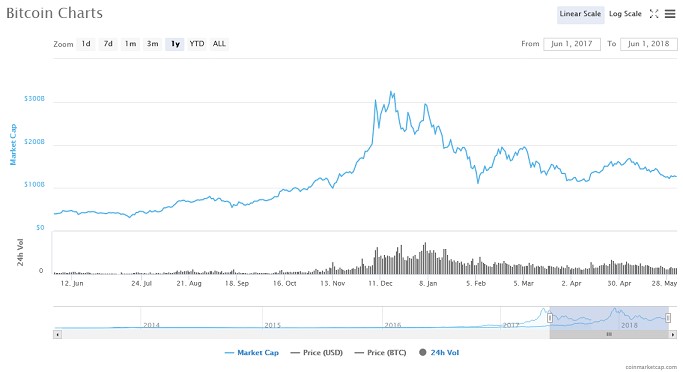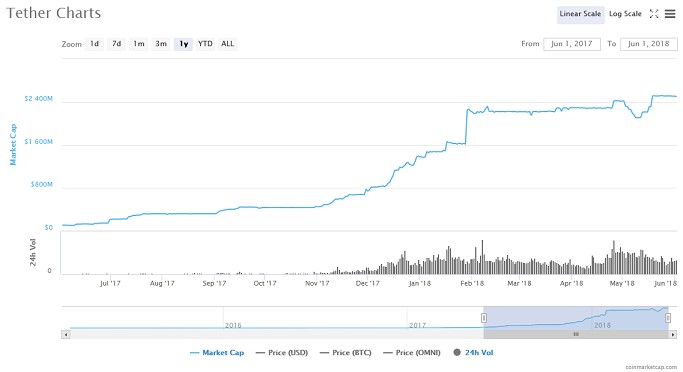When bitcoin sneezes, the rest of the crypto market catches a cold.
For the vast majority of cryptocurrencies, a bad day for bitcoin means a bad day for them, and vice-versa. The correlation between bitcoin and the rest of the crypto universe is very high and they mostly seem to move in lockstep.

(Click to enlarge)

(Click to enlarge)
Source: CoinMarketCap
You can call it following the leader. Of course, there are exceptions to this trend, such as when bitcoin losses translate to gains for some cryptos. For instance, alternative protocol assets rallied after the SEC rejected a proposed bitcoin ETF in March. But then, some others, such as Tether, just seem to have a mind of their own.

(Click to enlarge)

(Click to enlarge)
Source: CoinMarketCap
But, by and large, bitcoin is the leader in the space while everybody else follows. And that doesn’t make a lot of sense when you consider that every crypto is backed by an independent open-source technology, including the hordes of bitcoin clones.
The Ripple Effect
But Ripple's CEO, Brad Garlinghouse, reckons that it's about time we begin to see the crypto market behaving rationally with various degrees of decoupling between individual cryptos and the top dog.
Garlinghouse says the nascent industry is still largely driven by speculation mostly because there are so many cryptocurrencies that people don't understand very well. He claims most cryptos have no real utility, and a massive shakeout will see to it that 99 percent of cryptos won't be here a decade down the line.
Of course, he capped it all by claiming that Ripple itself has real utility, and will survive the test of time.
Related: The Indisputable Link Between Gold And Energy Prices
Maybe the CEO felt the need to talk up his brainchild after the pounding it received during the last crypto sell-off, which led to its XRP token cratering 82 percent from its January all-time high.

(Click to enlarge)
Source: CoinMarketCap
But what does Ripple do (or claim to do)?
Blockchain technology can be used to lower costs of money transfers by reducing or eliminating the need for banks to manually settle transactions. Ripple is a blockchain-powered interbank money transfer platform, while XRP is its crypto token. You can think of it as the blockchain equivalent of SWIFT, the leading electronic platform when it comes to interbank money transfers.
But what purpose does Ripple serve that SWIFT does not?
According to Garlinghouse, the current banking model whereby liquidity needs are managed via nostro and vostro accounts, which hold trillions of dollars, is highly inefficient. Using digital assets to fund liquidity is a better model, and Ripple is better-positioned to capitalize on it than other cryptos. For instance, the XRP token takes just 3.6 seconds to settle a transaction compared to four hours for bitcoin. Related: EV Sales Are Set To Triple In Two Years
Ripple can help banks move money from point A to point B cheaply and in record time. Further, the XRP token can be used as a bridge currency and a lingua franca that helps banks avoid the hassle of tying up money in varying currencies at foreign accounts.
Sounds like a fairly compelling business case on paper, especially when you consider that banking networks around the world move around $76 billion a day. But do banks need it?
Unfortunately, banks have been giving Ripple and XRP the cold shoulder. Although Ripple has signed up lots of banks on its network, only Stockholm-based Skandinaviska Enskilda Banken AB has actually used RippleNet in a money transfer, moving just shy of $1 billion in payments. Even Ripple investors Santander and Standard Chartered have only been testing the network and haven’t yet really taken the plunge.
That's not very encouraging considering that Ripple has been around for nearly seven years now. It appears that banks are balking at Ripple and XRP mainly due to regulatory hurdles. Further, the main movers of cross-border payments are large corporates, and it's going to be mighty tough to convince them to forego established banking networks in favor of a digital startup.
In this David-and-Goliath struggle, Garlinghouse’s confidence that Ripple and XRP won’t eventually join thousands of others in the crypto graveyard may be misplaced.
By Alex Kimani for Safehaven.com
More Top Reads From Safehaven.com

















